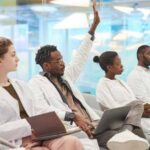 During the height of the pandemic four years ago, I took every precaution to avoid, or at the very least, delay contracting COVID-19. I religiously wore a mask in all public settings, I washed my hands so frequently that my skin became dry and cracked, and I studiously maintained a six-foot distance from others. But one measure I did not take was avoiding handshakes in the clinic.
During the height of the pandemic four years ago, I took every precaution to avoid, or at the very least, delay contracting COVID-19. I religiously wore a mask in all public settings, I washed my hands so frequently that my skin became dry and cracked, and I studiously maintained a six-foot distance from others. But one measure I did not take was avoiding handshakes in the clinic.
During a pandemic in which this was particularly frowned upon in favor of waves and other no-touch greetings, this may seem like a curious gesture to be so adamant about.1 However, I contend that a firm exploratory handshake gets to the root of what it means to be an excellent clinical rheumatologist. And that’s only the beginning.
The musculoskeletal physical examination, which includes careful observation of the hands through everyday gestures like handshakes, is part of an enduring legacy from generations of clinicians. So what role does the clinical exam play today, and how will it change in the future? Let’s rheuminate!
The Human Touch
First and foremost, there is something innate and magical about the human touch. One of the five senses, touch is particularly resonant, especially when it comes to establishing trust. Being open to engaging in touch and being examined is a sign of mutual respect and connection.2 It is also a profound means of communication on a nonverbal level—the subtleties of how a finger lands on a joint can express volumes of our intentions to understand another person’s condition and health.3
Additionally, years of research have established the neuropsychological effects of touch, including increased levels of dopamine and serotonin, neurotransmitters that regulate mood and reduce anxiety.4 It is no coincidence that good doctors are often spoken about as having the magic touch. In that respect, the physical examination is more than just a diagnostic tool, but also an important element of the healing process.5
The physical examination is also largely a part of the expectation that patients experience when they come to the rheumatologist’s office.6 Through prior experiences, popular culture and social media, patients have come to believe that a visit is only complete once a physician takes a look, touches and listens to their body. Although that obviously has changed somewhat with the pandemic, the advent of telemedicine and trends toward shorter clinic times that lead to abbreviated examinations, the physical examination is still very much a part of what we do and how we build relationships with our patients.


